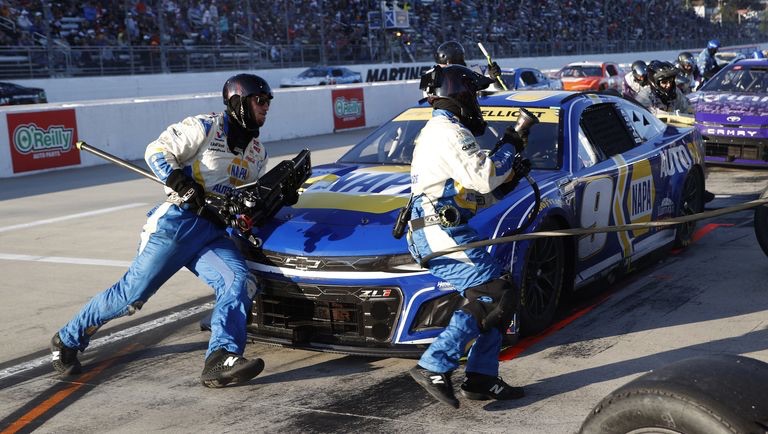The Risks of Pit Road: NASCAR’s High-Speed Challenge
Over the years, NASCAR has implemented numerous safety regulations to reduce the dangers of pit road, but with pit stops now taking less than 10 seconds and pit lanes remaining narrow, the risks have only intensified.
William Byron highlighted how competitive pit road has become, noting that even a slight delay can cost drivers multiple positions. “Pit stops are incredibly fast,” Byron said. “An 8.5-second stop is top-tier, while a 9.5-second stop is considered slow. The pressure leads to a lot of aggression because every tenth of a second matters.”
Chase Elliott echoed Byron’s concerns, describing pit road as a major challenge for drivers and a high-risk environment for pit crews. “These guys put a lot of trust in us as we maneuver inches away from them,” Elliott explained. “The combination of fast stops, aggressive strategy calls, and tight pit lanes makes it a dangerous place every week.”
Ricky Stenhouse Jr. pointed out that more cars on the lead lap means more traffic on pit road, increasing the chances of incidents. Since pit stops are so quick, cars entering first are often leaving while others are still trying to get into their stalls, creating chaos.
Near Misses and Costly Mistakes
During the recent race at Homestead-Miami Speedway, Elliott and Ryan Blaney narrowly avoided a collision on pit road. As Elliott exited his stall, Blaney had to make a last-second maneuver to avoid a crash. Elliott later explained that his attention was on nearby crew members rather than incoming traffic. “I was focused on the crew guys ahead of me,” he said. “I was told I was clear, but I could sense someone was there—turns out it was Blaney.”
The same race also saw Josh Berry and Joey Logano spin on pit road after Berry made contact with Kyle Larson while leaving his stall. The collision caused Berry to spin into Logano, forcing both drivers to stop in their stalls facing backward. Reviewing the incident later, Berry admitted he could have waited for Logano to leave first, even if it meant losing a few positions.
Additionally, Daniel Suárez spun while attempting to enter pit road, and Elliott was penalized for not maintaining single-file entry. Elliott defended his move, saying he wasn’t trying to gain an advantage but was instead trying to avoid hitting another car. “Pit road stacks up badly,” he said. “It’s happened a lot this year, and I’ve had some hard hits just trying to get onto pit road.”
NASCAR’s History of Pit Road Accidents
Pit road safety has improved significantly over the years, but the risks remain. Elliott acknowledged that his father, Bill Elliott, witnessed some of NASCAR’s most severe pit road accidents.
One of the most notorious incidents occurred in 1987 at Riverside International Raceway, where Michael Waltrip lost control and struck Bill Elliott’s pit crew. Several crew members suffered serious injuries:
- Chuck Hill (rear tire changer) had his spleen removed, suffered liver damage, a dislocated hip, and a broken arm.
- Steve Colwell (tire carrier) broke his jaw, lacerated his chin, and fractured his knee.
- Butch Stevens (jackman) sustained three fractures to his knee.
- Dan Elliott (front tire changer and Bill’s brother) suffered severe bruises on his shoulder and leg.
In 1990 at Atlanta, a tragic accident occurred when Ricky Rudd’s car lost control on pit road, slamming into Elliott’s crew. The most devastating consequence was the loss of Mike Rich, the rear tire changer, who was pinned between two cars and later died from his injuries. Other crew members, including Dan Elliott and Tommy Cole, were also hurt, with Dan undergoing multiple back surgeries in later years due to injuries from these incidents.
The Balance Between Speed and Safety
Chase Elliott acknowledged that while NASCAR has made significant safety improvements since those tragic events, pit crews still face considerable risks. “It’s way better than it used to be—no question—but these guys are still in danger every week,” he said.
With the growing speed of pit stops, aggressive strategy calls, and limited space on pit road, NASCAR drivers and teams must remain hyper-aware of their surroundings. Elliott emphasized that the key to safety lies in heightened awareness and precision: “We just have to stay sharp and remember that we’re racing around human beings who are putting themselves at risk for us every time we stop.”


























































